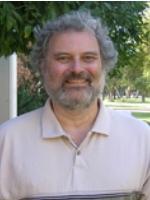2008
Illuminating Biology: an Evolutionary Perspective
October 16, 2008
Educational Resources Workshop
October 17, 2008
Memphis, TN
Click here for the web based version of the Illuminating Biology: an Evolutionary Perspective CD
The 2008 symposium focused on the benefits of applying evolutionary theory in biological sub-disciplines where evolutionary concepts have not traditionally played a prominent role. The four speakers offered examples of successful evolutionary based research in biochemistry, molecular biology and neurobiology. Resources to help educators bring this message back to their students can be found on the CD. The presentations and additional resources may be found with the speaker bios on this page.
Speakers
 Joram Piatigorsky - National Eye Institute, MD
Joram Piatigorsky - National Eye Institute, MD
Gene Sharing and Evolution: Surprising Lessons from Lens Crystallins
Among the most discussed mechanisms for change in protein functions are gene duplications, which provide new sources for making altered proteins by mutagenesis. We have developed the concept of “gene sharing” through our studies on lens crystallins. Lens crystallins are abundant water-soluble proteins of the transparent lens responsible for its optical, refractive properties required for focused vision. Gene sharing refers to the fact several functions can share the identical gene. In the case of crystallins, a major increase in the expression of the gene in the lens leads to a new function without loss of the original function. Paradoxically this means that functional specialization and diversification may occur simultaneously. Gene sharing shows that neither gene duplication nor change in protein structure is necessary for functional innovation and evolution. Gene sharing occurs widely and appears to be a fundamental principle of evolution.
(Download from iTunes U)
Additional resources for Dr. Piatigorsky's presentation:
- Piatigorsky, J. 2008. A Genetic Perspective on Eye Evolution: Gene Sharing, Convergence and Parallelism. Evolution:Education and Outreach Vol 1(4):403-414. DOI:10.1007/s12052-008-0077-0. (This article is open access and is found in the "Evolution of Eyes" edition of the journal.)
- Really weird eyes in a deep sea fish
 Robert Blankenship - Washington University in St. Louis, MO
Robert Blankenship - Washington University in St. Louis, MO
Evolutionary Relationships Among Phototrophic Bacteria Deduced from Whole Genome Comparisons
The invention and perfection of photosynthesis is without question one of the true milestones in the evolution of life on Earth. The development of the ability of some photosynthetic organisms to oxidize water to form molecular oxygen changed the redox balance of the Earth and provided the energetic basis for more advanced life to develop. This talk will discuss the complex nonlinear evolutionary path that has led to the modern process of photosynthesis.
(Download from iTunes U)
 Trisha Wittkopp - University of Michigan, MI
Trisha Wittkopp - University of Michigan, MI
Bringing an evolutionary perspective to developmental biology.
The genetic and molecular mechanisms controlling development are the product of evolution and can influence the way in which traits evolve. This talk will discuss the ways in which an appreciation of natural history and evolutionary processes can enhance our understanding of animal development.
(Download from iTunes U)
Additional resources for Dr. Wittkopp's presentation:
- References for the evolution of bat wings from paws:
- Cooper, K.L., and Tabin, C.J. 2008. Understanding of bat wing evolution takes flight. Genes Dev. Vol 22:121-124; doi:10.1101/gad.1639108
- Cretekos, C.J., Wang, Y., Green, E.D. 2008. Regulatory divergence modifies limb length between mammals. Genes Dev. Vol 22:141-151; doi:10.1101/gad.1620408
- References for the evolution of beak shape in Darwin's finches:
- Patel, N.P. 2006. Evolutionary biology: How to build a longer beak. Nature 442: 515 - 516, doi: 10.1038/442515a
- Abzhanov, A, Kuo, W.P., Hartmann, C., Grant, B.R., Grant, P.R., Tabin C.J. 2006. The calmodulin pathway and evolution of elongated beak morphology in Darwin's finches. Nature 442: 563 - 567, doi: 10.1038/nature04843
- References for morphological changes during corn domestication:
- Doebley, J.F., Gaut, B.S., Smith, B.D. 2006. The Molecular Genetics of Crop Domestication. Cell Vol 127(7):1309-1321. DOI 10.1016.j.cell.2006.12.006
- References for variation in human lactose intolerance:
- Wooding, S.P. 2005. Following the herd. Nature Genetics 39:7 - 8, doi: 10.1038/ng0107-7
- Tishkoff, S.S., Reed, F.A., Ranciaro, A., Voight, B.F., Babbitt, C.C., Silverman, J.S., Powell, K., Mortensen, H.M., Hirbo, J.B., Osman, M., Ibrahim, M., Omar, S.A., Lema, G., Nyambo, T.B., Ghori, J., Bumpstead, S., Pritchard, J.K., Wray, G.A., Deloukas, P. 2005. Convergent adaptation of human lactase persistence in Africa and Europe. Nature Genetics Vol 39: 31 - 40, doi: 10.1038/ng1946
- References for evolution of body aromor of the three-spine stickleback:
- Gibson, G. 2005. The synthesis and evolution of a supermodel. Science 307:1890-1891 [DOI: 10.1126/science.1109835]
- Colosimo, P.F., Hosemann, K.E., Balabhadra, S., Villarreal, G., Dickson, M., Grimwood, J., Schmutz, J., Myers, R.M., Schluter, D., Kingsley, D.M. 2005. Widespread Parallel Evolution in Sticklebacks by Repreated Fixation of Ectodysplasin Alleles. Science Vol 307: 1928-1933 [DOI: 10.1126/science.1107239]
- HHMI 2005 Holiday Lectures on Evolution
- Sean Carroll's resources for educators
 Georg Striedter - UC Irvine, CA
Georg Striedter - UC Irvine, CA
Large and complex brains evolved repeatedly
Large and complex brains evolved not just in primates, but also in other taxonomic groups, including octopuses, manta rays, electric fishes, parrots, crows, dolphins, and elephants. Most of these species are highly social. Although the brains of different species share myriad similarities, they also differ in many respects. Dr. Striedter aims to understand how and why those species differences arose. To that end, he asks how the brains of different species diverge in their development. The aim of such questions is to determine what evolutionary changes in the cellular and molecular mechanisms of development underlie the species differences in adult brains.
(Download from iTunes U)
Additional resources for Dr. Streidter's presentation
- Videos of crow behaviour from the Oxford Behavioural Ecology Research Group, Dr. Alex Kacelnik
- Comparative Brain Collections
- Introduction to Brain Evolution
A podcast interview with Georg Streidter in the Brain Science series by Dr. Ginger Campbell.
- Check Dr. Striedter's section of the NABT CD
Evolution Symposium Education Resources Workshop
Friday, Oct. 17
The workshop provided resources and training to support bringing the symposium materials into the classroom. Presenters from Understanding Evolution, BioQUEST, and NESCent offered hands-on introductions to activities that demonstrate applications of evolution. Understanding Evolution staff lead an inquiry investigation in which students follow the steps of scientists Steve Palumbi and Scott Baker, using evolutionary theory and DNA data to investigate whether whales are being illegally hunted and sold as meat in foreign markets. Materials for this activity are available on the CD. BioQUEST and NESCent staff presented "Identifying Biocontrol Agents Through Applied Systematics," which includes information on generating and reading phylogenies.
Other 2008 NABT Annual Conference Events
Presenters: Jeffrey McKinnon and Robert Kuzoff
A hands-on workshop that illustrates and explains the use of free and intuitive software to explore exciting events in the history of life.
Sponsored by the Society for the Study of Evolution.
Biogeography Symposium
Presenters: Joel Cracraft, Kathryn Perez, Frank Fontanella
Biogeography is the study of the patterns and processes of organismal distribution across space and time, and as such is a key discipline within evolutionary biology and ecology. For example, understanding how populations become geographically isolated is fundamental for deciphering the history of species’ origins. The distributions of organisms are also closely linked to climatic and geological history (such as mountain building, continental drift, formation of island arcs), and a goal of biogeographic analysis is to reconstruct those linkages. This symposium brought together a group of professional biologists specializing in biogeography. The presenters provided basic information and examples about the many ways in which biogeography can inform the teaching of biology. Topics included biogeographic principles, mapping distributions using Google Earth and other tools, how the breakup of the supercontinent Gondwana shaped the distribution of today’s organisms, and the biogeography of the Hawaiian islands. Teaching materials and resources were provided.
Co-sponsored by NESCent and the National Center for Science Literacy, Education and Technology, American Museum of Natural History.
